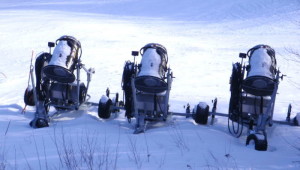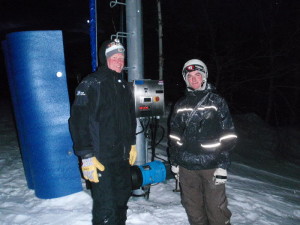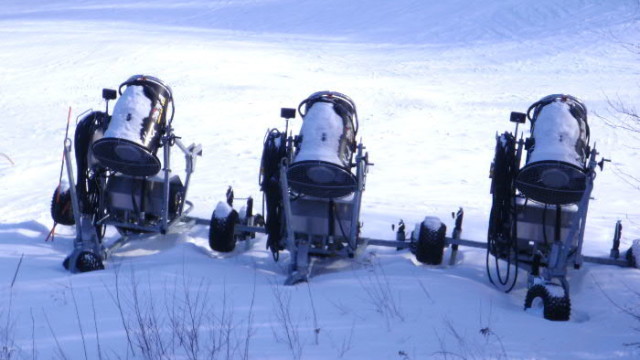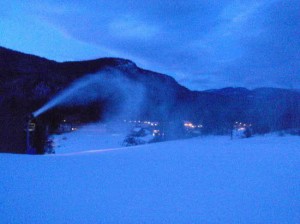
After my experiences talking to snowmakers for the earlier” Fan Guns” article, it was time to get out and actually see them at work. And where better to do it than at Attitash, which in the last few years has put $3 million into snowmaking, virtually all of it with fan guns? Lucky for me, the head of snowmaking, Kevin Kasten, was willing to take me under his wing and show me the system.
First, some background on Kevin. He’s been in snowmaking since 1983, when he started with Peak Resorts down in Missouri. Sounds bizarre, doesn’t it…isn’t that one of those southern states where they eat crawfish and gumbo and sweat a lot? Well…it’s not quite that bad. The top of MO is about equal with the bottom of PA. But, it’s a big difference from New England temperatures. Concord, NH has a mean daily temperature of 21 degrees in January; Columbia, Missouri, 30 degrees. That’s awfully close to the freezing mark, and that’s the coldest month of the year for them. So, snowmaking has to be precise, efficient, focused, and take advantage of every bit of technology available. Kevin started using early fan guns back then, so he literally grew up in the business with them.
Since then, he’s done a lot of travelling with Peak…pretty much blanketing the country east of the Rockies. In addition, he spent time in the off-season up here down under teaching Australian ski areas how to use fan guns in their humid climate (and picking up some unusual tastes in beer and cookies along the way). Now, what’s the problem with humidity? Turns out that it’s the natural enemy of snowmaking.
The basic process of snowmaking is forcing cold water and cold air through nozzles, producing…well, slush. Ever skied through the output stream of a traditional snow gun? You’re soaking wet immediately, the stuff freezes to you, and you can’t see through your goggles until you scrape the junk off. Not fun. Add more humidity, and it’s even harder for the stuff to dry…making it icier and icier. That’s why really cold temperatures are good for traditional snowmaking; the air is drier, and more of it freezes into small pellets before it hits the slopes.
This is where fan guns, and particularly tower fan guns, separate themselves from the old guard. They use something called a “nucleator”, which produces a very fine pellet that freezes quickly. Those tiny frozen pellets are then shot through the stream coming out of the main nozzles, where they get coated with water that freezes over them, making a larger “snowflake”. Those “flakes” are then blown up and out of the gun at very high speeds. So, rather than starting with a fully wet mix, by the time the pellet leaves the gun it’s already partially frozen. Then, by blowing it up and out with high speed fans, it has more “hang time.” More time in the air means more time to dry out…and fine, relatively fluffy snow without even being groomed. Put that gun on top of a tower, and it throws the output 35 or 40 feet in the air, allowing it to spread out, dry, and land over a large area, rather than creating a mound of slush that has to be shoved around.
When I went out with Kevin, it wasn’t particularly cold…29 or 30 F. After he explained all of this stuff, he turned on the tower fan we were at. First things first…I felt like I was standing next to a 747. That fan is impressive. When he turned on the water, I was holding a non-waterproof video camera, and wanted to get the heck out of there before it got sluiced down and turned into an iceball. Turns out I needn’t have worried; under the fan gun, there was NO snow, slush, rain, anything. It was all going WAY over my head, and headed over the trail. So, Kevin and I took a walk out to the middle of the trail where it was all coming down. I tucked the camcorder partway into my jacket and turned my back to the gun to protect it from the wet snow as it came down…except there wasn’t any. What was landing on me was a fine, dry powder. Looking across the slope, it felt like one of those storms where it’s cold, cold, cold…you can see through the snow because the flakes are fine, but it piles up fast. And that’s exactly what the snow was like. Kevin stuck his arm out, and we watched the snow land on it…and then I tapped his sleeve, and it all fell off. And this was at temperatures where natural snow would likely be heavy and wet!

As evening descended, I followed Kevin and his lieutenant, Donny, up the slope, where they set up each gun individually. Checking air temperature and humidity, they made adjustments to assure that the snow was of consistent quality. As it got darker and colder, I developed a greater respect for the dedication of snowmaking professionals; at Attitash and around the East, at mountain after mountain, this same scenario was probably being played out simultaneously…highly experienced and trained people working to assure us of the best skiing conditions that they can. After another hour or so, I headed off to a warm room and a good meal, but they soldiered on. Thanks, Kevin, Donny, and all the other snowmakers…I look forward to getting back out there and learning more about what you do!




[…] This post was mentioned on Twitter by EasternSlopes, Attitash Ski Area. Attitash Ski Area said: Attitash Snowmaking: http://easternslopes.com/2010/01/29/the-guns-of-attitash/ […]
[…] that’s got 30, 40, 70, 100 trails open with consistent manmade snow? As we found in “The Guns Of Attitash“, the quality as well as the quantity of manmade snow has increased dramatically in recent […]